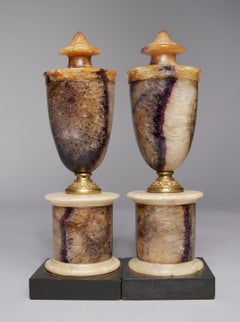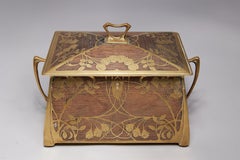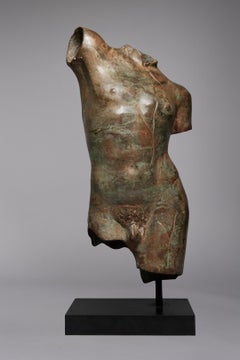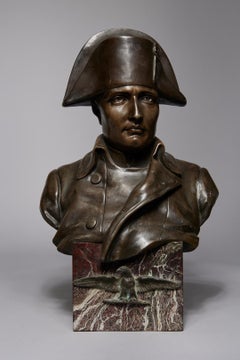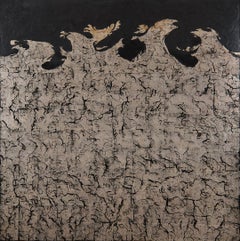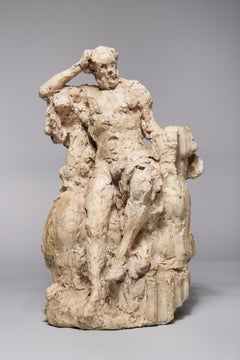WOLFS
to
5
338
156
97
57
51
49
39
34
30
27
25
22
15
15
11
10
8
7
7
7
5
4
4
3
2
2
2
1
1
59
49
31
15
13
Pair of English Regency Blue John (Derbyshire Spar) Urns, 19th Century
Located in Beachwood, OH
Pair of English Regency Blue John (Derbyshire Spar) Urns, 19th Century
9.5 x 3 x 3 inches
Obtained from the Derbyshire England, Blue John is a semi-precious mineral, a rare form of ...
Category
19th Century Figurative Sculptures
Materials
Marble
Erhard & Söhne Art Nouveau Jugendstil Jewelry Casque w/ Inlaid Brass Rose Design
Located in Beachwood, OH
Erhard & Söhne, 19th Century
Art Nouveau Jugendstil Casque with Inlaid Brass Rose Design, c. 1904
6 x 9 x 6 inches
The company Erhard & sons was established by Carl Gottlieb Erhard ...
Category
Early 1900s More Art
Materials
Brass
Patinated Bronze Torso after the Antique, 19th/20th Century
Located in Beachwood, OH
Patinated Bronze Torso after the Antique, 19th/20th Century
Bronze
Torso: 22 x 13 x 11 inches
Including base: 27 inches high
Category
Late 19th Century Figurative Sculptures
Materials
Bronze
Late 19th Century Bronze Bust of Napoleon Sculpture, Italian Artist
Located in Beachwood, OH
Raphaël Nannini (Italian, 1852-1925)
Napoleon Bust, Late 19th Century
Bronze on marble base
Signed on back
17 x 11 x 8 inches
Raphael Nannini was born in Florence. He exhibited at t...
Category
Late 19th Century Figurative Sculptures
Materials
Marble, Bronze
The Sea, Large Mid-Century Abstract Painting, Cleveland School Artist
By Clarence Van Duzer
Located in Beachwood, OH
Clarence Van Duzer (American, 1920-2009)
The Sea, c. 1950
Asphaltum, encaustic and silver leaf on masonite
Signed upper left
48.5 x 48 inches
In the annals of Cleveland art history,...
Category
1950s Abstract Paintings
Materials
Silver
Model Study for Truth Sculpture at NY Public Library of Seated Man
By Frederick William MacMonnies
Located in Beachwood, OH
Frederick William MacMonnies (American, 1863-1937)
Model Study for Truth, c. 1910-14
Painted plaster
16.5 x 9.25 x 7.5 inches
For the 1920 sculpture for the New York Public Library
...
Category
1910s Figurative Sculptures
Materials
Plaster
Seated Nude Woman Sculpture, Early 20th Century
By William Zorach
Located in Beachwood, OH
William Zorach (American, 1887-1966)
Seated Woman
Painted plaster
Inscribed underside "V"
12.5 x 9 x 5 inches
Provenance: The Tatti Family Collection
Bill Zorach was born in Lithuan...
Category
Early 20th Century Figurative Sculptures
Materials
Plaster
Early 20th Century Modern Bronze Scorpion Fish on Marble Base
Located in Beachwood, OH
Modern Scorpion Fish, Early 20th Century
Bronze on marble base
23 x 22 x 10 inches
Category
Early 20th Century Figurative Sculptures
Materials
Marble, Bronze
Mercury Standing on the Breath of Zeus, Antique Grand Tour
By Giambologna
Located in Beachwood, OH
After Giambologna (Italian, 1529-1608)
Mercury Standing on the Breath of Zeus
Bronze
27.5 x 14.25 x 5.5 inches
The sculpture depicts Mercury wearing his winged helmet and sandals and holding a caduceus. Created after one of Giambologna's most celebrated sculptures in the Renaissance, Mercury, was designed as part of a fountain for the Villa Medici in Rome.The head on which Mercury steps symbolizes the figure being “exhaled, purified, unburdened.” When the Giambologna sculpture...
Category
19th Century Figurative Sculptures
Materials
Bronze
Grand Tour Sandaled Foot of an Antiquity, 19th Century Italian
Located in Beachwood, OH
Grand Tour Italian, 19th Century
Sandaled Foot of an Antiquity
Bronze
5.5 x 12 x 5 inches
Category
19th Century Figurative Sculptures
Materials
Bronze
19th Century Bust of Antinous as Bacchus/Dionysus w/ Gilt Floral Wreath
Located in Beachwood, OH
Bust of Antinous as Bacchus/Dionysus with Gilt Floral Wreath, 19th Century
F. Barbedienne foundry
Gilt bronze
23 x 12 x 14 inches
Antinous, also called Antinoös, was a Greek youth f...
Category
19th Century Figurative Sculptures
Materials
Bronze
Petroglyph Vessel, Large Contemporary Figural Glass Blown Form
By William Morris (b. 1957)
Located in Beachwood, OH
William Morris (American, b. 1957)
Petroglyph Vessel
Blown glass
Signed on bottom
26 x 20 x 7 inches
William Morris was born in Carmel, California in 1957. He is an American glass a...
Category
Late 20th Century Figurative Sculptures
Materials
Blown Glass
20th Century French School Large Bronze Sculpture of a Semi-Nude Dancer
Located in Beachwood, OH
20th Century French School
Dancer
Patinated bronze
38 x 18.5 x 9 inches
Provenance: The Tatti Family Collection
Category
20th Century Figurative Sculptures
Materials
Bronze
Mountain Goat, 20th Century Bronze Sculpture of Animal, Cleveland School Artist
Located in Beachwood, OH
William McVey (American, 1905-1995)
Mountain Goat
Bronze
Signed by foot
14 x 3.5 x 6 inches
William McVey (12 July 1905-31 May 1995) became Cleveland's most visible artist largely t...
Category
20th Century Figurative Sculptures
Materials
Bronze
Evening Still Life, Dark 20th Century Landscape, Post Impressionism
By Joseph O'Sickey
Located in Beachwood, OH
Joseph B. O'Sickey (American, 1918-2013)
Evening Still Life
Oil on canvas
Signed lower right
32 x 24.5 inches
34.25 x 27.25 inches, framed
Joseph O'Sickey, born in Detroit in 1918, ...
Category
Late 20th Century Post-Impressionist Still-life Paintings
Materials
Oil
Bust of Diane de Poitiers, Bronze sculpture of French Noblewoman
Located in Beachwood, OH
After Jean Goujon (French, 1510-1568)
Bust of Diane de Poitiers
Bronze with gilt socle base
9 x 3.75 x 2.75 inches
Provenance: Removed from a private residence at the Pierre Hotel
Di...
Category
19th Century Figurative Sculptures
Materials
Bronze
Swan Baby, 19th Century Bronze & Marble Sculpture of Cherub Riding Swan
Located in Beachwood, OH
Auguste Moreau (French, 1834-1917)
Swan Baby, 19th Century
Bronze with reddish gold patination mounted on verdigris marble base
Signed on base
6 x 9.5 x 5 inches
Auguste Moreau was...
Category
19th Century Figurative Sculptures
Materials
Marble, Bronze
Tiffany & Co. 19th Century Bronze Cherub on Marble Base
Located in Beachwood, OH
Tiffany & Co.
19th Century Cherub
Bronze on marble base
Engraved on back of base
Sculpture: 6 x 13.5 x 7 inches
Overall: 7.5 x 15.5 x 9 inches
Tiffany & Co. is an American luxury je...
Category
19th Century Figurative Sculptures
Materials
Marble, Bronze
18th Century French Terra Cotta Bust of a Young Gentleman
Located in Beachwood, OH
18th Century French Terra Cotta
Bust of a Young Gentleman
Terra Cotta
Unsigned
25 x 18 x 10 inches
41 lb.
Category
18th Century Figurative Sculptures
Materials
Terracotta
Winter Rooftops, Backyard Landscape, American Scene Cleveland School Artist
By Carl Frederick Gaertner
Located in Beachwood, OH
Carl Frederick Gaertner (American, 1898-1952)
Winter Rooftops, 1945
Oil on board
Signed and dated lower right
9.5 x 13 inches
17 x 20.5 inches, framed
Carl Gaertner was one of the g...
Category
1940s Landscape Paintings
Materials
Oil
The Meeting, Large Mid-Century Painting of Seated Women, Woman Artist
Located in Beachwood, OH
Eleanor Arnold Clark (American, 1911-1982)
The Meeting
Oil on canvas
Signed lower right
25 x 29 inches
36 x 40 inches, framed
Eleanor Arnold Clark was born in Pittsburgh, Pennsylva...
Category
Mid-20th Century Figurative Paintings
Materials
Oil
Broken Ice, Large Mid-20th Century Gouache, Op Art Cleveland School Artist
By Edwin Mieczkowski
Located in Beachwood, OH
Edwin Mieczkowski (American, 1929-2017)
Broken Ice, 1976
Gouache and pencil on paper
Signed, dated (Feb. 2, 1976) and titled lower right
27.5 x 37.75 inches
35 x 45 inches, framed
Edwin Mieczkowski, born in Pittsburgh, was a leader of geometric and perceptual abstraction during the latter part of the 20th century. Mieczkowski's work first came to prominence in "The Responsive Eye" exhibition, the nation's first major exhibition of perceptual art, held at the Museum of Modern Art in New York in 1965.
Mieczkowski was also featured in the 1964 article in Timemagazine that first used the term "Op Art" to describe paintings that manipulated visual cues in order to reorder and excite viewers' perceptual responses.
With a complex aesthetic that over time has transcended mere tricks of optical art, Mieczkowski has spent nearly four decades producing geometrically paintings, drawings and sculptures, a genre of modern art that is known broadly as perceptual abstraction.
His output of static and dynamic forms create a body of work, still largely intact, that uses visually disorienting, meticulously arranged lines, dazzling kaleidoscopic colors, and alluring juxtapositions of hue and tone, to playfully and seductively present new challenges for the viewer's eyes. The desired result is an optical effect of perpetual motion, harmonics and rhythm. . . .
Along with Frank Hewitt and Ernst Benkert, Mieczkowski was a co-founder in 1959 of the Anonima* group that worked together in Cleveland and New York and declared itself free from the pressures of the art market and the pursuit of personal fame. Members of Anonima often left their works unsigned and vowed to shun the usual art market venues such as commercial galleries, biennials and competitions. Instead, they engaged in a rigorous, self-imposed program of painting exercises to explore the effects of geometry and color on visual perception.
Although Mieczkowski's work hung side-by-side in the MOMA "Responsive Eye" exhibition with such colleagues as Josef Albers, Victor Vasarely, Richard Anuszkiewicz, Morris Louis, Kenneth Noland, Carlos Cruz-Diaz, Ad Reinhardt and Bridget Riley, all of whom went on to considerable fame and fortune, Mieczkowski chose to eschew commercial exhibition and career promotion. Instead, he spent 39 years teaching at the Cleveland Institute of Art and quietly executing a number of public art commissions while independently pursuing his own intuitive explorations in geometric abstraction.
Mieczkowski pursued virtually no commercial sales of his work. Consequently, the body of work he left behind consists of hundreds of paintings, drawings and sculptures only recently viewed...
Category
1970s Op Art Figurative Paintings
Materials
Gouache, Pencil
French Faience Tuilerie Normande Mesnil de Bavent Ceramic Figure of a Lion
Located in Beachwood, OH
French Faience Tuilerie Normande Mesnil de Bavent
Figure of a Lion, 19th Century
Ceramic on a rectangular plinth
Impressed 'TN Bavent' to underside
8 x 8 x 14 inches
Tuilerie Normande Mesnil de Bavent is a French pottery factory.
The first pottery factory here was set up in 1842 by industrialist Maurice Comptet. He bought a bit of production organization to an artisanal craft, enabling mass production of tiles, pots and architectural ornaments. The Tuilerie du Mesnil de Bavent (tuilerie means tile) business flourished and his sons inherited. One stayed in Bavent to make pots, the other developed a factory mainly producing pots, in Caen.
Bavent pottery...
Category
19th Century Figurative Sculptures
Materials
Ceramic
18th Century English Double Handle Footman
Located in Beachwood, OH
English Double Handle Footman, 18th Century
Brass
12 x 18 x 17 inches
Category
18th Century More Art
Materials
Brass
Wooden Jellyfish Sculpture, Cedar Wood on Maple, Contemporary Artist
Located in Beachwood, OH
Daniel Grantham (American, 20th Century)
Jellyfish, 2017
Cedar wood on maple
Engraved signature on bottom of base
20 x 6.5 x 6 inches
Daniel Grantham was born and raised in Clevela...
Category
2010s Figurative Sculptures
Materials
Wood, Cedar, Maple
Portrait of Seated Woman Reading Julia Maud De Forest, Late 19th Century
Located in Beachwood, OH
Ora Coltman (American, 1858-1940)
Julia Maud De Forest, 1898
Watercolor on paper
Signed and dated upper left
9.25 x 12.75 inches
15 x 18.25 inches, framed
Ora Coltman was born in 18...
Category
1890s Portrait Drawings and Watercolors
Materials
Watercolor
The Grand Canyon, vibrant mid-20th century western landscape
By Andreas Roth
Located in Beachwood, OH
Andreas Roth (American, 1871-1949)
Grand Canyon, 1943
Oil on canvas
Signed and dated lower right
24 x 34 inches
29.5 x 39 inches, framed
Andreas Roth was a German painter. Son of th...
Category
1940s Landscape Paintings
Materials
Oil
Landscape Scene with Barn and Trees, Late 19th Century, Ohio Artist
By Addison Thomas Millar
Located in Beachwood, OH
Addison Thomas Millar (American, 1860-1913)
Barn scene, 1892
Oil on board
Signed and dated lower left
10.25 x 13.5 inches
15 x 18.5 inches, framed
Addison Thomas Millar was an American painter and artist; best known for his genre scenes and Orientalist paintings.
He was born to William H. Millar and Permelia Kennedy Millar. His father had emigrated to the United States from Scotland in 1845. He grew up in Warren, Ohio. During his primary education, he took some painting lessons from John Bell, a local landscape painter.
In his late teens, he won three consecutive awards from The Youth's Companion, in their annual art contests. This prompted his parents to allow him to go to Cincinnati to take formal lessons from the genre painter, De Scott Evans...
Category
1890s Landscape Paintings
Materials
Oil
Large Painting, Changing Bear Maiden, Nude Woman Laying w/ Wolf, Taos Artist
Located in Beachwood, OH
Cynthia Bissell (American, 1924-2000)
Changing Bear Maiden, 1962
Oil on canvas
Signed and dated lower right
20 x 50 inches
26 x 56 inches, framed
Cynthia Bissell was an American art...
Category
1960s Figurative Paintings
Materials
Oil
Bridge in the Cleveland Flats, Late 20th Century Architectural Painting
Located in Beachwood, OH
William Gould (American, 1930-2017)
Bridge in the Flats, 1990
Watercolor on Arches paper
Signed and dated lower right
21 x 28.5 inches
28 x 35.5 inches, framed
Cleveland Arts Prize ...
Category
1990s Figurative Drawings and Watercolors
Materials
Watercolor
In the Art Gallery, Early 20th Century Watercolor, Women Viewing Painting
Located in Beachwood, OH
Jules Andre Smith (American, 1880-1959)
In the Art Gallery, 1936
Watercolor and pen and ink
Signed Andre Smith, 1936 lower right
10.75 x 8.5 inches
20.25 x 17.25 inches, framed
Jule...
Category
1930s Figurative Drawings and Watercolors
Materials
Pen, Ink, Watercolor
La Clarinette et La Baignoire, The Clarinet and the Bathtub and Birdcage
By Max Herve
Located in Beachwood, OH
Max Herve (French, 1926-2018)
La Clarinette et La Baignoire
oil on canvas
signed lower right
21.5 in. h x 25.75 in. w., canvas
28 in. h. x 31.25 in. w., as framed
Max Hervé was an a...
Category
Late 20th Century Figurative Paintings
Materials
Oil
Sentada Desnuda, Surreal Painting of a Seated Nude Woman, Mexican Artist
By Guillermo Meza
Located in Beachwood, OH
Guillermo Meza (Mexican, 1917-1997)
Sentada Desnuda, 1941
Oil on canvas
Signed and dated lower right
23.5 in. h. x 19.5 in. w.
31 in. h. x 27 in. w., as framed
He was born in México...
Category
1940s Surrealist Figurative Paintings
Materials
Oil
Late 19th Century Portrait of a Nun, Italian Artist
Located in Beachwood, OH
Luigi Morgari (Italian, 1857–1935)
The Nun
Oil on canvas mounted on board
Signed lower right
14 x 12 inches
21.5 x 19.5 inches, framed
There is a minor chip to the bottom right corn...
Category
Late 19th Century Figurative Paintings
Materials
Oil
Cubist Landscape/Cityscape of Capri, Italy, Early 20th Century Woman Artist
Located in Beachwood, OH
Clara Deike (American, 1881-1965)
Capri, 1927
Watercolor on paper
Signed and dated lower right
11 x 10 inches
14.25 x 13.25 inches, framed
A graduate of the Cleveland School of Art ...
Category
1920s Cubist Figurative Drawings and Watercolors
Materials
Watercolor
Large Rhinoceros, 20th Century Magical Realism, Cleveland School Artist
By Paul Riba
Located in Beachwood, OH
Paul Riba (American, 1912-1977)
Rhino
Oil on paper
Signed lower right
22.5 x 29 inches
27.5 x 34.25 inches, framed
Paul Riba was a painter of Magic Realism. He explored the unreal ...
Category
20th Century Surrealist Animal Paintings
Materials
Oil
Bighorn Sheep, 20th Century Oil Painting by Magical Surrealist, Cleveland School
By Paul Riba
Located in Beachwood, OH
Paul Riba (American, 1912-1977)
Bighorn Sheep
Oil on paper
Signed lower right
25 x 30.5 inches
30.5 x 36 inches, framed
Paul Riba was a painter of Magic Realism. He explored the un...
Category
20th Century Surrealist Animal Paintings
Materials
Oil
Around the Kitchen Table, Late 20th Century Family Scene, Cleveland Artist
Located in Beachwood, OH
Dale Slavin (American, 1946-2024)
Around the Kitchen Table, 1987
Oil on canvas
Signed lower right
43 x 42 inches
Dale had an accomplished art career serving as a sculptor, painter ...
Category
1980s Figurative Paintings
Materials
Oil
Sleeping Ariadne, Large Bronze & Marble Sculpture of Greek Mythology, 19th C.
By Pietro Chiapparelli
Located in Beachwood, OH
Pietro Chiapparelli (Italian, 19th Century)
Sleeping Ariadne, c. 1865
Bronze on marble base
Inscribed 'P. Chiapparelli F.I. Roma'
22 x 24 x 10.5 inches
136 lb.
(34 lb. bottom marble,...
Category
1860s Figurative Sculptures
Materials
Marble, Bronze
French Village Landscape Scene w/ Trees & Buggy, Early 20th Century
Located in Beachwood, OH
Auguste-Louis Lepère (French, 1849-1918)
Untitled Landscape, c. 1910
Watercolor
Signed lower right
14 x 16.5 inches
20 x 22.5 inches, framed
Auguste-Louis Lepère was a French painte...
Category
1910s Figurative Drawings and Watercolors
Materials
Watercolor
Skinny Dippers, 20th Century Landscape, Swimming Family, Italian Artist
By Louis Bosa
Located in Beachwood, OH
Louis Bosa (American, 1905-1981)
Skinny Dippers
Oil on board
Signed lower right
15.5 x 20 inches
21.25 x 25.5 inches, framed
Born in Codroipo, a small village only a few miles from ...
Category
1960s Figurative Paintings
Materials
Oil
19th Century Grand Tour Bronze of the Uffizi Wrestlers
Located in Beachwood, OH
After Lysippos (Greek, 390 BC-300 BC)
19th Century Grand Tour Bronze of the Uffizi Wrestlers
Bronze
J. Chiurrazi & Fils, Naples
17 x 20 x 12 inches
76 lb.
The Wrestlers is a Roman m...
Category
19th Century Figurative Sculptures
Materials
Bronze
Aegean Temple, Dystopian Surrealist Landscape, Cleveland School Artist
By John Teyral
Located in Beachwood, OH
John Teyral (American, 1912-1999)
Aegean Temple, 1966
Oil on canvas
Signed and dated lower left
25 x 34 inches
John Teyral was one of Cleveland's most acclaimed artists. He exhibite...
Category
1960s Figurative Paintings
Materials
Oil
Ladies Dancing in the Park, Lush Green Landscape, Early 20th Century
Located in Beachwood, OH
Marie Martelli-Chautard (French, 1884-1982)
Afternoon in the Park
Oil on panel
Signed lower right
47 x 31 inches
52 x 36.5 inches, framed
Category
Early 20th Century Figurative Paintings
Materials
Oil
Moody Beach Scene, Surreal Mid-Century Figurative Familial Scene Italian Artist
By Louis Bosa
Located in Beachwood, OH
Louis Bosa (American, 1905-1981)
The Beach, c. 1960
Oil on board
Signed lower left
11.75 x 19.5 inches
20 x 28 inches, framed
Born in Codroipo, a small village only a few miles fro...
Category
1960s Figurative Paintings
Materials
Oil
20th Century Figural Abstract Expressionist Oil Painting by Woman Artist
Located in Beachwood, OH
Lucile E Lundquist Blanch (American, 1895 - 1981)
Abstract
Oil on panel
Signed lower right
10 x 8 inches
17 x 15 inches framed
Painter and lithographer Lucille Linquist Blanch, born in Hawley, Minnesota in 1895, was, by her mid-thirties, already represented by a number of paintings in the collection of the Whitney Museum of American Art. She would receive a Guggenheim Fellowship in 1933.
She studied at the Minneapolis Art Institute during World War I, 1914 to 1918, with fellow students Harry Gottlieb...
Category
20th Century Abstract Abstract Paintings
Materials
Oil
Still Life of Man Holding Bird, Surreal Cleveland Woman Artist
By Mary Spain
Located in Beachwood, OH
Mary Spain (American, 1934–1983)
Man with Bird
Oil on canvas
Signed middle right
13.5 x 11.75 inches
17 x 15 inches, framed
Set in a realm of fantasy, Mary Spain’s work exhibits odd...
Category
1970s Surrealist Figurative Paintings
Materials
Oil
Still Life w/ Flowers, Bust & Parisian Scene, American Impressionist
By Abel Warshawsky
Located in Beachwood, OH
Abel Warshawsky (American, 1883-1962)
Still Life
Oil on canvas
Signed upper right
32 x 25.5 inches
Provenance: From the Alexander Warshawsky Estate
Impressionist painter A.G. Wars...
Category
1950s Impressionist Still-life Paintings
Materials
Oil
Cactus (Mexico), Early 20th Century Cubist Still Life by Woman Cleveland Artist
Located in Beachwood, OH
Clara Deike (American, 1881-1964)
Cactus (Mexico), 1930
Watercolor on paper
Signed lower right, titled and dated on label verso
15.25 x 13.25 inches
25 x 22.5 inches, framed
A gradu...
Category
1930s Cubist Still-life Drawings and Watercolors
Materials
Watercolor
On the Balcony, Two Women Seated at Table, Woman Cleveland Artist
Located in Beachwood, OH
Thelma Frazier Winter (American, 1905-1977)
On the Balcony
Pastel on paper
Signed lower right
20 x 16 inches
Thelma Frazier Winter was an American enamelist, ceramic sculptor, and p...
Category
Mid-20th Century Figurative Drawings and Watercolors
Materials
Pastel
New England Coastal Town Landscape w/ Houses, Cleveland School Woman Artist
Located in Beachwood, OH
Kae Dorn Cass (American, 1901-1971)
New England Coastal Town
Watercolor on paper
Signed lower right
9 in. h. x 11.5 in. w.
17 in. h. x 19 in. w., as framed
Kae Dorn Cass was born...
Category
Mid-20th Century Figurative Drawings and Watercolors
Materials
Watercolor
1940 Large Portrait of a Woman, Kae Dorn Cass, by Cleveland School Artist
By Rolf Stoll
Located in Beachwood, OH
Rolf Stoll (American, 1892-1978)
Kae Dorn Cass, 1940
Oil on canvas
Signed upper right
32 x 25 inches
38 x 31 inches, framed
Exhibited:
The 27th Annual May Show, Cleveland Museum of Art, Cleveland, OH, 1940
This work won first prize for oil painting- Portrait category
Provenance:
Collection of Kae Dorn Cass's niece
Kae Dorn Cass
Rolf Stoll
Rolf Stoll, a painter of figure subjects, landscapes and floral still lifes, was an important member of the Cleveland art scene during the second quarter of the century. He was also an influential teacher, as well as one of Ohio’s foremost portrait painters.
Rolf Stoll was born in Heidelberg, Germany, in 1892. As a boy, he attended a military academy, during which time he developed an interest in art. He received his early formal training at the Academy of Fine Arts in Karlsruhe and at the Academy of Fine Arts in Stuttgart. He emigrated to the United States in 1912, settling in New York City. A decade later, after studying at the school of the National Academy of Design and supporting himself by working as a commercial artist, Stoll decided to leave New York. Upon the recommendation of Warren Pryor, one of his teachers, he decided to move to Cleveland, Ohio. After arriving in Cleveland, Rolf Stoll continued to work as a commercial artist. However, in 1926, he joined the faculty of the Cleveland School of Art, where he taught drawing. Two years later Stoll was appointed head of the school’s portrait painting department. A talented portraitist, Stoll’s sitters included industrialists, community leaders and many prominent members of Cleveland and Ohio society, as well as over twenty faculty members from Case Western Reserve University. Stoll also gave portrait classes at the John Huntington Polytechnic Institute from 1926 to 1953. In his male portraits especially, he was admired for his ability to convey the dignity of his sitter’s professional position without sacrificing individuality. As noted by one contemporary reviewer, Stoll was a “master of rich color, a searching student of human types, a forceful portrayer of all that the face reveals of the mind and the soul.” In addition to his activity as a portraitist, Rolf Stoll painted figure subjects and floral still lifes. He was also known for his views of the Ohio countryside...
Category
1940s Portrait Paintings
Materials
Oil
Costa Brava, Spain, Nuns w/ Umbrellas & Chairs, Surrealist Scene
By Louis Bosa
Located in Beachwood, OH
Louis Bosa (American, 1905-1981)
Costa Brava, Spain
Oil on board
Signed lower right
14 x 24 inches
23 x 33 inches, framed
Born in Codroipo, a small village only a few miles from Ven...
Category
Mid-20th Century Surrealist Figurative Paintings
Materials
Oil
Rocky Cove, Mid-20th Century Landscape/Seascape by Cleveland School artist
By Carl Frederick Gaertner
Located in Beachwood, OH
Carl Frederick Gaertner (American, 1898-1952)
Rocky Cove, 1947
Oil on canvas
Signed lower left
24 x 30 inches
31 x 37 inches, framed
Carl Gaer...
Category
1940s Figurative Paintings
Materials
Oil
Night Riders, Mid-20th Century Surrealist Landscape w/ Horse & Riders
Located in Beachwood, OH
Hugh M. Poe (American, 1902-1973)
Night Riders, 1962
Oil on artist's board
Signed lower right
20 x 25 inches
26.75 x 31.75 inches, framed
Condition: Craquelure throughout. There are...
Category
1960s Surrealist Figurative Paintings
Materials
Oil
Wart Hog, 20th Century Oil Painting by Magical Surrealist, Cleveland School
By Paul Riba
Located in Beachwood, OH
Paul Riba (American, 1912-1977)
Wart Hog
Oil on paper
Signed lower right
18 x 15 inches
24.25 x 21 inches, framed
Paul Riba was a painter of Magic Realism. He explored the unreal j...
Category
Mid-20th Century Surrealist Animal Paintings
Materials
Oil
Walrus Oil Painting, 20th Century Magical Realism Artist, Cleveland School
By Paul Riba
Located in Beachwood, OH
Paul Riba (American, 1912-1977)
Walrus
Oil on paper
Signed lower right
29.25 x 24.5 inches
34.75 x 30 inches, framed
Paul Riba was a painter of Magic Realism. He explored the unrea...
Category
Mid-20th Century Surrealist Animal Paintings
Materials
Oil
Rain Garden II, Contemporary Figural Abstract Landscape, New York Artist
Located in Beachwood, OH
Cathy Diamond (American, 20th Century)
Rain Garden II, 2023
Pigment dispersion and acrylic on paper
Signed lower left, signed and dated verso
11 x 14 inches
Cathy Diamond currently ...
Category
2010s Abstract Paintings
Materials
Acrylic, Pigment
Marble Figure of a Recumbent Lion, 19th Century
Located in Beachwood, OH
Figure of Recumbent Lion, 19th Century
Carved gray veined marble
4.5 x 8 x 4.5 inches
Category
19th Century Figurative Sculptures
Materials
Marble
Contortionist Nude, 20th Century Bronze of Nude Female, Cleveland Artist
Located in Beachwood, OH
David Deming (American, 20th Century)
Contortion Nude
Bronze
Signed on base
14 x 12 x 9 inches
David Deming is a nationally recognized contemporary Ameri...
Category
Late 20th Century Figurative Sculptures
Materials
Bronze
